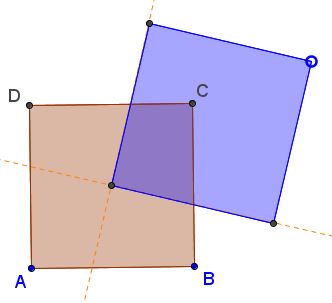Area of the Union of Two Squares
Squares ABCD and MNOP are congruent with side length 10, and O is the center of ABCD. What is the area of the region covered by the union of these squares [First Steps, p. 81].
3 November 2016, Created with GeoGebra
References
- J. D. Faires, First Steps For Math Olympians, MAA, 2006
|Activities| |Contact| |Front page| |Contents| |Geometry|
Copyright © 1996-2018 Alexander Bogomolny

The main point to observe is that the area of the intersection of the two squares is exactly 1/4 that of ABCD. In fact (and hopefully the applet helps with this realization), the area of the intersection and even its shape does not depend on the size of the second (MNOP) square as long as it is big enough to include a corner of ABCD. The extended side lines ON and OP of MNOP cut ABCD into four equal regions the same for all M on a fixed line through O.
The area covered by the union of the two squares is the sum of their areas minus the area of the intersection:
102 + 102 - 102/4 = 175.
In a more general case where the side length of MNOP is a, with a greater than the half diagonal of ABCD, the area of the union is given by
102 + a2 - 102/4.
The book offers a different proof based on the following diagram:

where, after interchanging two equal right triangles, the intersection of the squares transforms into a clear quarter of ABCD.
(In a different vein: could you evaluate the difference of the remaining portions of the two squares without finding the area of their intersection? It is done for circles!)
In [Trigg, #121] the same problem is given with an extra condition that one of the squares divides a side of the other in a ratio 1:2, which is of cause a red herring.
References
- C. W. Trigg, Mathematical Quickies, Dover, 1985, #12
What Is Red Herring
- On the Difference of Areas
- Area of the Union of Two Squares
- Circle through the Incenter
- Circle through the Incenter And Antiparallels
- Circle through the Circumcenter
- Inequality with Logarithms
- Breaking Chocolate Bars
- Circles through the Orthocenter
- 100 Grasshoppers on a Triangular Board
- Simultaneous Diameters in Concurrent Circles
- An Inequality from the 2015 Romanian TST
- Schur's Inequality
- Further Properties of Peculiar Circles
- Inequality with Csc And Sin
- Area Inequality in Trapezoid
- Triangles on HO
- From Angle Bisector to 120 degrees Angle
- A Case of Divergence
- An Inequality for the Cevians through Spieker Point via Brocard Angle
- An Inequality In Triangle and Without
- Problem 3 from the EGMO2017
- Mickey Might Be a Red Herring in the Mickey Mouse Theorem
- A Cyclic Inequality from the 6th IMO, 1964
- Three Complex Numbers Satisfy Fermat's Identity For Prime Powers
- Probability of Random Lines Crossing
- Planting Trees in a Row
- Two Colors - Three Points
|Activities| |Contact| |Front page| |Contents| |Geometry|
Copyright © 1996-2018 Alexander Bogomolny73575201
